Battle of Chapultepec
The Battle of Chapultepec on 13 September 1847 was an assault by invading American forces on a small contingent of Mexican forces holding the strategically located Chapultepec Castle just outside Mexico City. The building, sitting atop a 200-foot (60 m) hill, was an important position for the defense of the city. For the campaign to take Mexico City, of which the Battle of Chapultepec is a part, General Winfield Scott's U.S. Army totaled 7,200 men. General Antonio López de Santa Anna deployed Mexican forces to several sites to defend the capital, so that just 880 troops, including military cadets of the Military Academy defended the position at Chapultepec against 2,000 U.S. forces. The Mexican forces' loss opened the way to take the center of Mexico City. In Mexican history, the battle is cast as the story of the brave deaths of six cadets, the Niños Héroes, who leaped to their deaths rather than be taken captive, with one wrapping himself in the Mexican flag. For the U.S. there are many depictions of the battle from their point of view.[3] Although it lasted only about 60–90 minutes, the battle has great importance in the histories of both countries.
| Battle of Chapultepec | |||||||
|---|---|---|---|---|---|---|---|
| Part of the Mexican–American War, Battle for Mexico City | |||||||
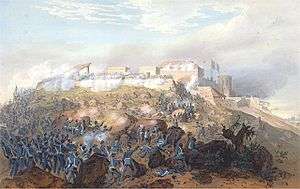 Battle of Chapultepec. Carl Nebel, 1851 | |||||||
| |||||||
| Belligerents | |||||||
|
|
| ||||||
| Commanders and leaders | |||||||
|
|
| ||||||
| Strength | |||||||
|
7,200 Total Army including 400 Marine Corps Engaged at the Battle on Chapultepec approx 2,000[1] |
15,000 Total Mexican Army Engaged at the Battle on Chapultepec 880 total250: 10th Infantry 115: Querétaro Battalion 277: Mina Battalion 211: Union Battalion 27: Toluca Battalion[1] | ||||||
| Casualties and losses | |||||||
|
138 killed 673 wounded[1] 29 missing[2]:321 |
600–675 killed 100 wounded 100 captured[2]:321 | ||||||
Scott's campaign to take Mexico City

Scott had taken a risk by marching inland from the port of Veracruz, going beyond his supply lines. He fought a major battle at Cerro Gordo, but encountered virtually no resistance in capturing Mexico's second largest city, Puebla. He then pushed further toward the capital. Scott avoided the direct route from Puebla to Mexico City because the road was heavily defended at El Peñon. Instead he cut a road looping south of Lake Chalco and Lake Xochimilco to the town of San Agustín. The Mexican defenders blocked the route to the capital at Hacienda of San Antonio, with marshes to their north and a lava field to the south, known as the Pedregal. General Pillow's division cut a road for artillery through the Pedregal to engage the entrenched Mexican forces under General Gabriel Valencia at Contreras on 20 August. The Mexicans were routed and the U.S. forces pressed on. Santa Anna fortified the ex-convent at Churubusco and there was fierce fighting there. There was a two-week armistice following the battle.[4]
On September 8, 1847, in the costly Battle of Molino del Rey, U.S. forces had managed to drive the Mexicans from their positions near the base of Chapultepec Castle guarding Mexico City from the west. However, Army engineers were still interested in the southern causeways to the city.[2]:311 General Winfield Scott held a council of war with his generals and engineers on September 11.[2]:311 Scott was in favor of attacking Chapultepec and only General David E. Twiggs agreed.[2]:312 Most of Scott's officers favored the attack through the southern gates, including Captain Robert E. Lee.[2]:312 A young lieutenant, P. G. T. Beauregard, gave a speech that persuaded General Franklin Pierce to change his vote in favor of the western attack.[2]:312 Given that Mexican forces defended fortified positions tenaciously and had inflicted severe casualties on U.S. forces at Molino del Rey, and Cerro Gordo, the decision to attack Chapultepec was not taken lightly.[5]
Battle
General Antonio López de Santa Anna was in command of the army at Mexico City and understood that Chapultepec Castle was an important position for the defense of the city.[2]:313 The castle sat atop a 200-foot (60 m) tall hill which was used as the Mexican Military Academy.[2]:313 Although Santa Anna's total forces defending Mexico City were larger than Scott's, he had to defend multiple positions, since he did not know from where the attack would come. He did not have enough troops to effectively defend both the southern causeways into Mexico City and Chapultepec Castle, at a distance from the capital. At Chapultepec, General Nicolás Bravo had fewer than 1,000 men[2]:313 (832: Total including 250: 10th Infantry, 115: Querétaro Battalion, 277: Mina Battalion, 211: Union Battalion, 27: Toluca Battalion and 42: la Patria Battalion with seven guns(Gen. Manuel Gamboa with 2–24 lbs, 1–8 lb., 3–4 lbs. & 1 howitzer (68) ) to hold the hill, including 200 cadets, some as young as 13 years old. Also defending the castle was the Batallón de San Blas under the command of Lieutenant Colonel Felipe Xicoténcatl, a hero of the battle, along with six cadets who died defending the castle. Thinking that the attack would come from the south, Santa Anna devoted preparation time and troops there, both before and during the bombardment. It was not until the U.S. troops were actually on the hill that he realized his mistake, but by then it was too late.
Chapultepec Castle was not built as a fortress but as a luxury residence, later converted to the military academy. It was obviously strategically positioned, but its stone walls were vulnerable to cannon-fire. U.S. forces used its heavy artillery to bombard the castle before the infantry attack. The Mexican forces had attempted to fortify the defenses by digging shallow trenches and placing sandbags. During the artillery bombardment, there was nowhere for the defenders to shelter and there was no way for them to defend against this attack from a distance. Destruction of the walls, sandbags, and other defenses was demoralizing for many defenders and some began abandoning their positions. Only when the bombardment went on all day did Santa Anna realize the main attack was to be on Chapultepec. If he sent forces there, they would be exposed to U.S. fire in the flat land below the hill, and they could not reach the hill to help the defenders there during the bombardment. Santa Anna consulted with Nicolás Bravo, confessing to him that many of his demoralized troops were also likely melt away if sent into a situation that would have high casualties.[6]
Scott organized two storming parties of about 250 men each for 500 men total including 40 Marines.[7][2]:313 The first party consisted of Captain Samuel Mackenzie's 256 men and Gideon Pillow's division, who would advance from the Molino east up the hill.[2]:313 The second storming party consisted of Captain Silas Casey's men and John A. Quitman's division, advancing along the Tacubaya road.[2]:313 However, Casey was replaced by Major Levi Twiggs. Only Twiggs' division and Bennett Riley's brigade were left on the American right flank.[2]:312
The U.S. forces began an artillery barrage against Chapultepec at dawn on September 12.[2]:312 It was halted at dark and resumed at first light on September 13.[2]:316 At 8 AM, the bombardment was halted and General Scott ordered the infantry attack.[2]:316 There were three assault columns. On the left were the 11th and 14th Infantry under Colonel William Trousdale moving east along the Anzures aqueduct, in the center were four companies of the Voltigeur regiment under Colonel Timothy Patrick Andrews along with the 9th and 15th Infantry moving through the swamp and western edge of the grove, and on the right were the remaining four Voltigeur companies under Lieutenant Colonel Joseph E. Johnston.[2]:316
Pillow was quickly hit in the foot and called for reinforcements, which came from John A. Quitman's division but the attack faltered when fired upon by the Moelia Battalion battery.[2]:317 Andrews's column cleared the grove of Mexican troops and linked up with Johnston.[2]:316 The attack by the 9th and 15th Infantry stalled waiting for scaling ladders, and Col. Truman B. Ransom, commander of the 9th Infantry, was killed.[2]:316–317
Quitman sent Persifor Smith's brigade to his right and brought in James Shields, plus the New York and 2d Pennsylvania Regiments into the assault.[2]:317 At the same time, Newman S. Clarke's brigade arrived on the western slope, as did the scaling ladders.[2]:317 The Voltigeurs soon planted their flag on the parapet.
By 9 AM, General Bravo surrendered to the New York Regiment and the American flag flew over the castle.[2]:318 Santa Anna watched the Americans take Chapultepec while an aide exclaimed "let the Mexican flag never be touched by a foreign enemy". He also exclaimed, "I believe if we were to plant our batteries in Hell the damned Yankees would take them from us."[2]:318
Los Niños Héroes
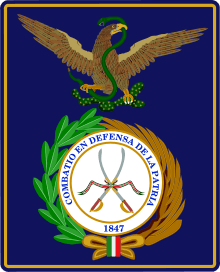
During the battle, five Mexican military cadets plus one of their instructors, refused to fall back when General Bravo finally ordered retreat and fought to the death.[2]:316 These were teniente (lieutenant) Juan de la Barrera and cadets Agustín Melgar, Juan Escutia, Vicente Suárez, Francisco Márquez and Fernando Montes de Oca, all between the ages of 13 and 19. According to legend, the last of the six, Juan Escutia, grabbed the Mexican flag, wrapped it around himself and jumped off the castle point to prevent the flag from falling into enemy hands. In 1967, Gabriel Flores painted a mural depicting "Los Niños Héroes".[8]
A mural decorates the ceiling of the palace, showing Juan Escutia wrapped in the flag, apparently falling from above.[9] A monument stands in Chapultepec Park commemorating their courage. The cadets are eulogized in Mexican history as Los Niños Héroes, the "Child Heroes" or Heroic Cadets.
Saint Patrick's Battalion
Thirty men from the Saint Patrick's Battalion, a group of former United States Army soldiers who joined the Mexican side, were executed en masse during the battle. They had been previously captured at the Battle of Churubusco. Colonel William S. Harney specified that they were to be hanged with Chapultepec in view and that the precise moment of their death was to occur when the U.S. flag replaced the Mexican tricolor atop the citadel.
Battles for the Belén and San Cosmé Gates
General Scott arrived at the castle and was mobbed by cheering soldiers.[2]:318 William J. Worth's division was sent by Scott to support Trousdale's men on La Verónica Causeway (now Avenida Melchor Ocampo) for the main attack against the San Cosme Gate.[2]:319 Defended by Gen. Rangel's Granaderos Battalion, part Matamoros, Morelia & Santa Anna Battalions (Col. Gonzalez), part 3d Light (Lt. Col. Echeagaray), & 1st Light (Comdt Marquez) Trousdale, followed by John Garland's, Newman Clarke's and George Cadwalader's brigades, began advancing up the causeway.
General Quitman quickly gathered the troops in Chapultepec, except the 15th Infantry who guarded the castle and prisoners, and designed as a feint, headed down the Belén Causeway stopping at the Belen Garita.[2]:318 The gate was manned by the Morelia Battalion, under the command of General Andrés Terrés' (three guns and 180 men : 2d Mexico Activos) and the paseo to the north by General Ramirez.[2]:318 Troops began to desert, and when Terres ran out of ammunition, he withdrew into the Ciudadela.[2]:319 Led by the Mounted Rifles (fighting on foot), Quitman breached the Belén Gate at 1:20 p.m.[2]:319 General Scott later commented "Brave Rifles, you have gone through fire and come out steel".[2]:319
It was 4 p.m. by the time Worth started his advance down the San Cosme causeway, having fended off an attack by 1,500 of Torrejon's cavalry.[2]:320 Garland's brigade used the arches of the aqueduct to advance on the right.[2]:320 Clarke's men on the right passed through a tunnel made by sappers.[2]:320 Lieutenant Ulysses S. Grant, and some 4th Infantry, used the bell tower of San Cosme Church south of the causeway to place a mountain howitzer.[2]:320 On the north side of the road, naval officer Raphael Semmes repeated Grant's successful maneuver.[2]:320 Lieutenant George Terrett then led a group of Marines behind the Mexican defenders and, climbing to the roof, unleashed a deadly volley on the artillery gunners.[2]:320 By 6 p.m., Worth had broken through the gate, and the defenders scattered, many retreating into the Ciudadela, sweeping Santa Anna along with them.[2]:320 As night fell, Worth lobbed five mortar rounds into the city which fell near the National Palace.[2]:321
Aftermath
The city was yet to be taken, Santa Anna had 5,000 troops in the Ciudadela (armory) and 7,000 in other parts of the city.[2]:321 Six of his generals were taken prisoner.[2]:321 At 1 AM the next day, he ordered a withdrawal to Guadalupe Hidalgo while the city authorities appeared at Scott's headquarters at 4 AM.[2]:321 By 7 AM the American flag was flying over the Ciudadela.[2]:321
Legacies
The efforts of the U.S. Marines in this battle and subsequent occupation of Mexico City are memorialized by the opening lines of the Marines' Hymn, "From the Halls of Montezuma...".
A number of lower-ranking U.S. Army officers participating in the invasion, became generals on both sides of the American Civil War, including Daniel H. Hill, Ulysses Grant, George Pickett, James Longstreet, John C. Pemberton, Thomas Jonathan "Stonewall" Jackson, and Robert E. Lee.
U.S. Marine tradition maintains that the red stripe is worn on the trousers of the Blue Dress uniform, commonly known as the blood stripe, because a large number of the Marine NCOs and officers of the detachment died while storming the castle of Chapultepec in 1847, though iterations of the stripe predate the war. In 1849, the stripes were changed to a solid red from dark blue stripes edged in red, which dated from 1839.[10][11]
In Mexico, the battle has a complicated place in historical memory, since the capture of Chapultepec led to the fall of Mexico City to the invaders. The fierce defense of Chapultepec by military cadets at the Military Academy, six of whom died by leaping from the walls to their deaths. The Niños Héroes ("Boy Heroes") were considered martyrs fighting to maintain Mexico's honor as a nation. Their bravery and innocence was lauded in Mexico, as opposed to the Mexican Army generals, particularly Antonio López de Santa Anna, blamed for Mexico's defeat.
In 1947, President Harry S. Truman laid a wreath on the 1881 cenotaph of the Niños Héroes as a gesture of goodwill after Mexico aided the U.S. in World War II.[12][13]
Gallery
 A painting of the American assault on the Chapultapec castle
A painting of the American assault on the Chapultapec castle_by_James_Walker.jpg) Battle of Chapultepec by James Walker, 1857
Battle of Chapultepec by James Walker, 1857 Attack on the Castle Chapultepec
Attack on the Castle Chapultepec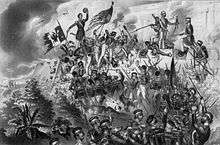 "Storming of Chapultepec in Mexico"
"Storming of Chapultepec in Mexico"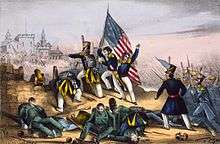 Attack on Chapultepec, Sept. 13th 1847.
Attack on Chapultepec, Sept. 13th 1847.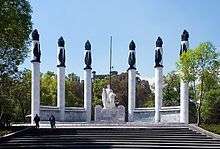 Monument to the six Heroic Cadets, with Chapultepec Castle in the background.
Monument to the six Heroic Cadets, with Chapultepec Castle in the background.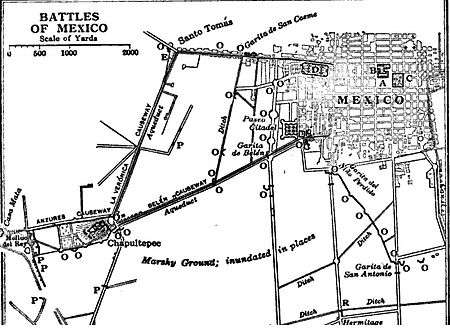 Molino del Rey is on the left. "O" depicts a Mexican battery, "P" an American battery, and "R" is Steptoe's battery.[1]
Molino del Rey is on the left. "O" depicts a Mexican battery, "P" an American battery, and "R" is Steptoe's battery.[1]
References
| Wikimedia Commons has media related to Battle of Chapultepec. |
- Smith, Justin H. (Justin Harvey) (1919). The war with Mexico. New York: Macmillan. Retrieved 26 September 2018 – via Internet Archive.
- Bauer, K.J., 1974, The Mexican War, 1846–1848, New York: Macmillan, ISBN 0803261071
- Sandweiss, Martha A., Rick Stewart, and Ben W. Huseman, Eyewitness to War: Prints and Daguerrotypes of the Mexican War, 1846-1848. Fort Worth TX: Amon Carter Museum of Western Art 1989.
- Sandweiss, et al. Eyewitness to War, pp. 301-18.
- Guardino, Peter. The Dead March: A History of the Mexican-American War. Cambridge: Harvard University Press 2017, pp. 271-72.
- Guardino, The Dead March, pp. 273-74
- Eisenhower, John S. D (26 September 2018). So far from God: the U.S. war with Mexico 1846-1848. Easton Press. OCLC 50686024.
- inter alia, Villalpando, José Manuel; Niños Héroes, México DF: Planeta, 2004; Hernández Silva, HC: "¿Quién aventó a Juan Escutla?", La Jornada, December 13, 1998; Rosas, Alejandro "Una historia mal contada: Los Niños Héroes", Relatos e Historias en México, year II No. 13, September 2009.
- "Mural of Cadet Jumping". Mexico 501. 2006-11-02. Archived from the original on 24 November 2009. Retrieved 2009-10-13.
- "Lore of the Corps". National Museum of the Marine Corps. Archived from the original on 5 November 2009. Retrieved 2009-10-13.
- Schogol, Jeff (October 22, 2010). "What's the real story of the "Blood Stripe"?". Stars and Stripes. Retrieved 26 September 2018.
- Peters, Gerhard; Woolley, John T. "Harry S. Truman: Address in Mexico City". The American Presidency Project. UCSB. Retrieved 26 September 2018.
- Wagenen, Michael Scott. The Forgotten War: The Enduring Legacies of the U.S.-Mexican War. Amherst: University of Massachusetts Press 2012, pp. 144-45
Further reading
- Alcaraz, Ramon et al. Apuntes Para la Historia de la Guerra entre Mexico y los Estados Unidos
- Eisenhower, John S. D., Agent of Destiny – The Life and Times of General Winfield Scott
- Kendall, George Wilkins. The War Between the United States and Mexico Illustrated. New York: D. Appleton & Co. 1851.
- Ramsey, Albert C. The Other Side
- Sandweiss, Martha A., Rick Stewart, and Ben W. Huseman. Eyewitness to War: Prints and Daguerreotypes of the Mexican War, 1846-1848. Fort Worth: Amon Carter Museum of Western Art, 1989.
- Annual Reports 1894, War Department lists trophy guns: 1- 24pounder bronze, 1- 8 inch howitzer and 2- 4-pounder bonze howitzers.
External links
- A Continent Divided: The U.S. – Mexico War, Center for Greater Southwestern Studies and UTA Libraries Special Collections, the University of Texas at Arlington
- Scott, Winfield. Official Report